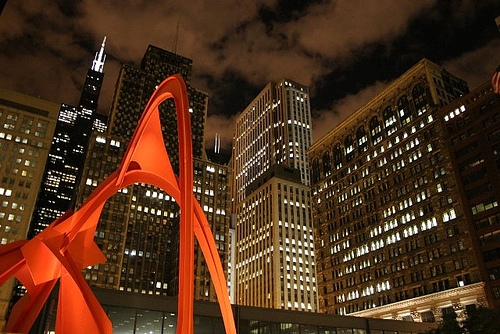While my graduate writing program at UofM is on break for the summer, I’ve adopted Chicago as my temporary home. And in the past several weeks, while strolling around town, seeking some inspiration for my next short story, and enjoying the lakefront path that winds from the northern to southernmost points of the city, I’ve come to realize that Chicago is overflowing with public art. Its statues, ornate fountains, and contemporary sculptures are casually integrated into some of the busiest parts of the the city, turning Chicago into a veritable walking museum that anyone can enjoy for free!
As a writer, I’ve always been interested in how an idea, a curiosity, or an experience evolves into tangible art. Though a lot of the basic inspiration for Chicago’s public art is more or less self-explanatory (i.e. Chagall’s Four Seasons is a mosaic tribute to just that — the physical and spiritual transitions experienced during Chicago’s four season’s,) I often find myself perplexed by the more abstract art that appears throughout the city. I spent the other day staring, mouth agape, at the sculpture below:

Wilting flower? Licorice Man in Motion? Giraffe with its head stuck in a hole?
A passerby saw me frozen in wonderment, then leaned in and said, “flamingo.”
I thanked him for that byte of information, and the sculpture’s resemblance to the pink Floridian bird began to show. But then it made me kind of sad. Why would someone cement this warm-weather bird into a city known for its cruel combination of year-round precipitation and biting wind? It seemed unkind… as though the unsuspecting giant was captured and being held hostage as a feathery spectacle. I pulled out my trusty smart phone to get the whole story.
As it turns out, Flamingo, created by Alexander Calder and first presented to Chicago’s public in 1974, was designed specially, not in spite of, the stark backdrop offered by the Kluczynski Federal Building. As you can see from the photo, the Kluczynski Building is an overwhelming structure — marked for its cold, geometric presentation. Apparently, the artist’s goal was not to install a sculpture that blended with this building, but instead, to offer striking visual contrast — a sort of reprieve from the otherwise dry, corporate landscape.
Standing 53-feet in the air, Flamingo‘s soft angles and long, forgiving arcs, serve as a reminder of what exists outside the bustling city. It’s a dose of much-needed perspective to Chicagoans (and part-time Chicagoans, like myself) who are so easily susceptible to the mechanized nature of any large urban area. And with its legs planted directly in the cement (without a typical artistic pedestal or platform), Flamingo doesn’t obstruct the pedestrian’s pathway, instead allowing people to walk right through its legs. So although it’s an enormous, red, and seemingly out-of-place structure, it’s well-integrated design gives off a friendly message, as though the bird is saying, “Oh, don’t mind me. I’m just taking a break from the city — relaxing with my head in this hole. Don’t you need a break, too?”

